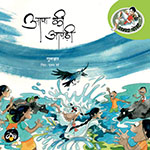The thing about nonsense verse is that while it seems like it has no meaning, the play of words is actually very meaningful. Gulzar’s Aapa ki Aapdi, accompanied by such wonderful art by Allen Shaw, is just that. The word ‘aapdi’ itself, probably a neologism, contains within its playful syllables the nature of being an Aapa—an older sister, perhaps bossy, perhaps a know-it-all. The book disrupts that power equation in a light-hearted and imaginative way. Anta Ghafeel, the delightful character found in another book by Gulzar, is presumably reciting this nonsense verse to entertain a band of children. Unpleasant things befall Aapa in the verse affecting her aapdi, the innate quality of being an older sister. She falls into a puddle of water and her aapdi, her bossiness is dampened. She is hung up to dry and her know-it-all-ness drips away. She is ironed to dry her out and the aapdi is flattened. And horror of horrors, she is discovered to have licked some slimy moss that was in the puddle and the only way to fix that is to have her drink soap and wash her out thoroughly. The Aapa that emerges is shiny and new, a bilori, a fluid tawny colour that changes like a kaleidoscope. Poor Aapa, at the mercy of disagreeable accidents and a gang of little kids who she has probably previously bossed over! The little children’s delight at her aapdi being reduced is so evident in the cheerful rhythm created by the use of repeated syllables and words. The chanting quality is broken periodically by a line containing a verb that works like a slogan—Aapa ko dhoop mein sukhao! Aapa ko istri karao! So, while it is indeed nonsense verse, the writing is a wonderful example of how language can be used to craft a pleasurable reading experience.
The art is splendid. Allen Shaw uses the fluidity of watercolours to create settings that are real and imaginative at the same time. For example, there is a spread of a village pond in which the action is in the foreground—children and buffaloes splash together while women wash clothes. But the composition plays with perspective imaginatively and fluid strokes of blue in the top half of the spread isolate this from reality. Similarly, the composition of a spread in which Anta Ghafeel is saying ‘Aapa ko dhoop mein sukhao!’ has him seen from a low angle with someone at a washing line in the top right corner, almost like a thought bubble. The quirkiness of the characters emerges through the use of line and colour such as the orange henna-coloured hair and beard of Anta Ghafeel, or the large eyes of the characters that sometimes convey shock and sometimes joy.
The book brings children and adults together in an unspoken way, underlining the importance of play. It is a wonderful example of how words and art can come together in picture books to create a truly joyful reading experience.
October 2023, volume 47, No 10

